Correction of errors - physical constants in the present and new versions of the International System of Units (SI)
March 29, 2019 - Michael Trott, Chief Researcher
- Introduction
- The world is discussing future changes.
- Overview of the relevant ingredients of the Wolfram Language
- Let's return to the letter to the editor.
- Calculating the table of error-optimized forms
Introduction
In the so-called "new SI" - an updated version of the International System of Units , which will define seven basic units of measurement (second, meter, kilogram, ampere, kelvin, mole and candela) and which will take effect on May 20, 2019, all units of measurement of SI will be determined by the exact values of the fundamental physical constants. As a result, all the SI units named (Newton, Volt, Ohm, Pascal, etc.) will ultimately be expressed in terms of fundamental constants. (Finally, fundamental physics will literally control our daily life ☺)
The table below shows how things will change from Monday evening, May 20 to Tuesday morning, May 21 of this year.
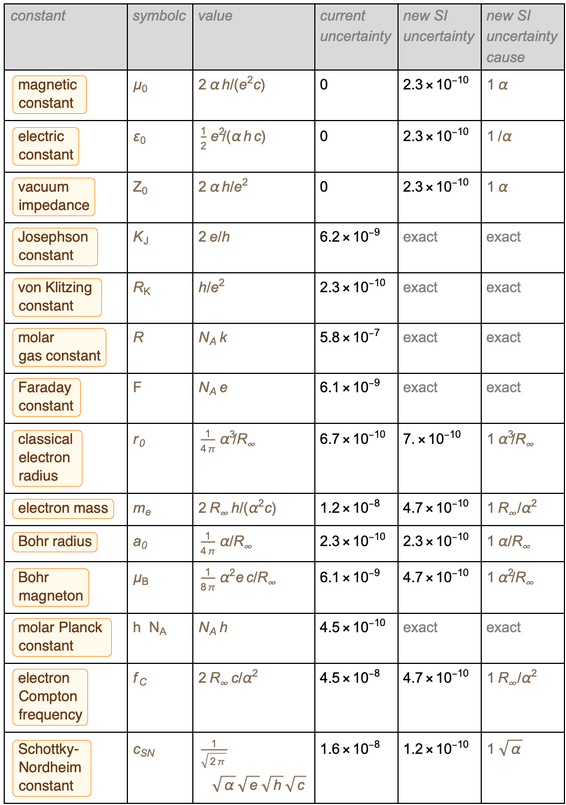
')
Calculation of data from this table is the goal of this blog. So let's start with a brief overview of what will change in the new SI.
In addition to the well-known exact value of the speed of light, in a few weeks four more physical constants — the Planck constant, the Boltzmann constant, the Avogadro constant, and the Millikan constant (more often called the elementary electric charge) —will have exact values. The decision on this change was made at the international level last November (I wrote about it in my last
Below is a fragment of page 12 of the current draft of the SI Booklet .
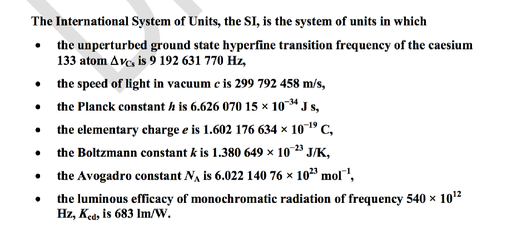
Note that in these definitions, decimal numbers are meant as exact decimal numbers, and not, say, machine numbers on a computer that have finite precision and are not exact numbers. The transition frequency in the split Cs-133 hyperfine structure, the speed of light and the "light efficiency" already today have exact values.
The world is discussing future changes.
This change will have some interesting consequences for other physical constants: some constants that are currently measured and have values with errors will become accurate, and some constants that currently have exact values will have approximate values with final errors in the future . These changes are inevitable to ensure overall system consistency.
The first issue of Physics of the World this year in a letter to the editor by William Gough touched upon this topic; He wrote:
With charge fixing on an electron ( e ) and Planck's constant ( h ), all physical units are now “immortalized in stone”, which is very nice. But this raises an awkward question. Fine structure constant
 where c is the speed of light and
where c is the speed of light and  this
this  . From familiar equations
. From familiar equations  and
and  we quickly find that
we quickly find that  . This is, of course, a pure number with a dimensionless quantity, and it is now forever fixed as equal to 1/137.13601, which is very close to the accepted value. This is not surprising, since the latter value would be used in the agreed new values for e and ℏ . But nature has its own value, unknown to us at the present time, which because of this is perpetuated in a diamond. We can be forgiven for hinting that we know better than nature. But what if the future theory of the universe becomes accepted, and gives the exact meaning
. This is, of course, a pure number with a dimensionless quantity, and it is now forever fixed as equal to 1/137.13601, which is very close to the accepted value. This is not surprising, since the latter value would be used in the agreed new values for e and ℏ . But nature has its own value, unknown to us at the present time, which because of this is perpetuated in a diamond. We can be forgiven for hinting that we know better than nature. But what if the future theory of the universe becomes accepted, and gives the exact meaning  which is significantly different from the accepted value? Could this happen? There have been attempts to find a theoretical value for α , but they include threatening and controversial quantum electrodynamics.
which is significantly different from the accepted value? Could this happen? There have been attempts to find a theoretical value for α , but they include threatening and controversial quantum electrodynamics. The problem is that in the new SI system both
 and
and  will now have inaccurate values with some error. In this blog, we will use the Wolfram Language and its knowledge of physical units and constants to see how these and other physical constants acquire (or lose) error, and why this is a mathematical consequence of the definition of basic units.
will now have inaccurate values with some error. In this blog, we will use the Wolfram Language and its knowledge of physical units and constants to see how these and other physical constants acquire (or lose) error, and why this is a mathematical consequence of the definition of basic units. Overview of the relevant ingredients of the Wolfram Language
The Wolfram Language is a unique environment for conducting numerical experiments and symbolic calculations, identifying possible consequences. In addition to general computing capabilities, three components of the system are very useful:
1) The units of the Wolfram Language and the structure of physical quantities.
“Classic” units (such as meters, feet, etc.) can be used in calculations and visualizations. And, of course, in the translation of units of measurement.

Conversion to ordinary US units leads to fractions (and not to an approximate value of a real number!) Due to precisely defined ratios of these two units.

Physicists (especially) love to use "natural" units. Often these natural units are simply physical constants or their combinations. For example, the speed of light (natural language input is used here).

Expressed in SI units (since this is speed and units are required in meters and seconds), the speed of light has an exact value.

On the other hand, the Planck constant is currently not accurate. Thus, its value, expressed in base SI units, is an approximate decimal number.


Please note that the accuracy of 6.626070 ... reflects the number of known digits.



This is the last recommended value for Planck's constant, published in CODATA 2017 to prepare for the specification of constants. Below is the corresponding table:
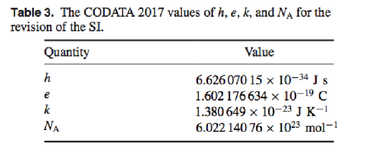
Physical constants (or combinations thereof) that connect two physical quantities can often be used as natural units. The simplest examples would be measuring speed in terms of the speed of light or microscopic angular momentum in terms of ℏ . Or energy can be measured in terms of mass with an implied multiplier.
 . The DimensionalCombinations function can be used to search for combinations of physical constants that allow you to link two specified physical quantities. For example, the following relationship between mass and energy can be built:
. The DimensionalCombinations function can be used to search for combinations of physical constants that allow you to link two specified physical quantities. For example, the following relationship between mass and energy can be built: 
The first equality reflects Einstein's famous formula.
 , the second is the equivalent of the first relation, and the third - (dimensionally) states that
, the second is the equivalent of the first relation, and the third - (dimensionally) states that  .
.2) The “ PhysicalConstant ” entity class, recently added to the Wolfram Knowledgebase .
Functions and objects in the Wolfram Language language are “generated computationally,” that is, they are ready for use in calculations as well. But to describe and simulate the real world, we need data about the real world. Entity structure is a convenient and fully integrated way to obtain such data. Below are some data about the electron, proton and neutron.
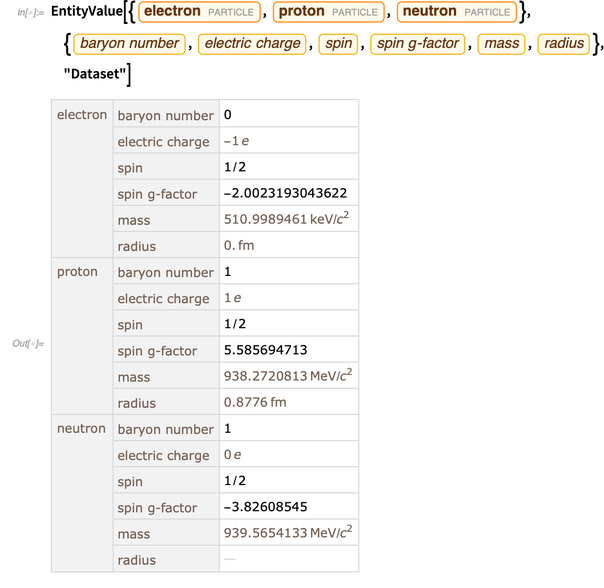
One of the new entity units is physical constants. Currently, the Knowledge Base contains more than 250 physical constants.

Below are a dozen randomly selected examples. And without a clear definition of what exactly the physical constants are, the masses of fundamental particles, the Lagrange parameters of the standard model, etc. For convenience, the list also contains astronomical constants in accordance with the Astronomical Almanac.

Most of the fundamental physical constants were called class C constants in the famous paper by Jean-Marc Levy-Leblond. The constants of the classes C and B are given below.


Take, for example, the natural unit of time, the time of Planck. The ToEntity and FromEntity functions make it easy to go back and forth between physical constants as units and physical constants as entities. The following is the essence of the Planck time unit.


The knowledge base has a lot of meta information about it, for example, its values in the latest CODATA lists.

The last conclusion, which contains the value and error, brings us to a third important function that will be useful later:
3) Introduction of the Around [] function in version 12 of the Wolfram Language. The Around [] function provides an inaccurate value, indicating the mean and error. The arithmetic model Around [] is based on the GUM (Guide to the Expression of Error in Measurements) - not to be confused with Plus-Minus-calculus Leibniz. Here is the value with an error.

The most important and useful aspect of calculations with values that have inaccuracies is that they properly take into account correlations. The naive use of such values in arithmetic numbers or intervals may underestimate or overestimate the error that occurs.

Below we see that the AroundReplace [] function takes into account the correlation.

Let's return to the letter to the editor.
Now let's use these three components and the more detailed letter from William Gough to the editor.
With current approximation values for e and ℏ , these two values for the fine structure constant agree within their errors. The first is the expression from the letter to the editor, and the second is the quantity ( Quantity []), which represents a fine structure constant.

Every few years, CODATA publishes the official values of the fundamental constants (see the fine structure constants ); as I said, the values used in the Wolfram Language are the last CODATA values and the final error is reflected in the exact numbers.
Notice that the directly measured value of the fine structure constant is slightly more accurate than the one that expresses the fine structure constant through other constants.

If we use the upcoming exact values of e and ℏ , and use the current exact value
 , we get the following exact value for the fine structure constant in the form
, we get the following exact value for the fine structure constant in the form  .
.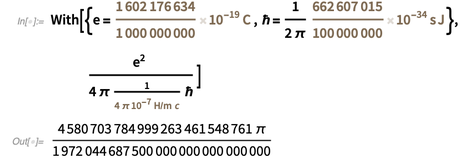
It is unlikely that the Lord, who does not even play dice , would choose such a number for
 in our universe. This means that while e and ℏ will be fixed in the new SI, the current exact values
in our universe. This means that while e and ℏ will be fixed in the new SI, the current exact values  and
and  must inevitably be “unclaimed” (see also the Goldfarb article on
must inevitably be “unclaimed” (see also the Goldfarb article on  new SI). (We will come back to why
new SI). (We will come back to why  and
and  should soon become inaccurate.)
should soon become inaccurate.) This means that after May 20 of this year, these results will be different from those shown below.


(In a brief note, the “ PhysicalConstant ” entity class also has suggested values for constants, such as the fine structure constant):


Now, apart from the theological argument about the exact form of the fine structure constant, from a physical point of view, why
 and
and  must be inaccurate? As an argument of probability, let's consider
must be inaccurate? As an argument of probability, let's consider  . One of the most outstanding results is the Coulomb law.
. One of the most outstanding results is the Coulomb law. 
In an existing SI system, an amp has an "exact" definition:
Amp is the constant current, which, if maintained in two parallel conductors of infinite length with a slight circular cross section and placed at a distance of 1 meter in a vacuum, will create between these conductors a force equal to
 Newton per meter length.
Newton per meter length. This definition uses the purely mechanical quantities Newton and Meter (that is, after expansion, it is a second, meter, and kilogram). No relationship with the electron charge is made, and in the existing SI system, the elementary charge is an experimentally measured quantity.

And this experimentally measured value has changed over the years becoming more accurate.

The force in the left part of the Coulomb's law (expressed in Newtons) contains the basic unit kilogram, which, after the value of Planck's constant becomes constant, also becomes precisely definable. Since there is no reason to assume that all laws of nature can be expressed in finite rational numbers, the only possible "moving part" in Coulomb's law will be
 . Its numerical value must be determined, and it will make the left and right side of Coulomb's law coincide.
. Its numerical value must be determined, and it will make the left and right side of Coulomb's law coincide. From a more fundamental point of view of physics, the fine structure constant is an interaction constant that determines the strength of electromagnetic interactions. And, perhaps, one day physics will be able to calculate the value of the fine structure constant, but we are still far from that. Just the choice of unit definitions cannot fix the value.
 .
. Are both
 and
and  Are they getting fixed, or is it possible to keep one of them accurate? Because of the already accurate speed of light and the ratio
Are they getting fixed, or is it possible to keep one of them accurate? Because of the already accurate speed of light and the ratio  if one of
if one of  or
or  accurate, the other must also be accurate. We know that at least one should become uncommitted, so it follows that both must be uncommitted.
accurate, the other must also be accurate. We know that at least one should become uncommitted, so it follows that both must be uncommitted. The values that are now given by Planck’s constant, Boltzmann’s constant, Avogadro’s constant and the elementary charge are neither arbitrary nor fully defined. They are defined up to about eight characters, so that the units that they define after May 20 correspond to the “size” of the units that they define before May 20. But the numbers on the bottom right are not defined. Thus, the value of the future exact value of the elementary charge can be
 , but not
, but not  . This is Occam's razor and rationality that allow us to use
. This is Occam's razor and rationality that allow us to use  .
. At a more technical level, the substitution in the previous calculation was that, through the term
 in the formula
in the formula  amp was used before override (remember
amp was used before override (remember  ), but the exact value of the elementary charge was also used, meaning the definition of ampere after redefinition. And we always need to stay in the same system of units.
), but the exact value of the elementary charge was also used, meaning the definition of ampere after redefinition. And we always need to stay in the same system of units. Calculation of error-optimized form table
So, the natural question arises: what should these “non-fixed” values be? In my last blog, I manually created a new value.
 . What can be done manually can be done using a computer program, so let's implement a small program that calculates the form of derivatives of physical constants optimized by error. In a future-oriented approach, an entity class of seven constants that defines a new SI is already available.
. What can be done manually can be done using a computer program, so let's implement a small program that calculates the form of derivatives of physical constants optimized by error. In a future-oriented approach, an entity class of seven constants that defines a new SI is already available.Below are the constants that will have the exact value in the new SI.

The current values of these constants together with their error (calculated using the Around [] function) are:

Using the “ PhysicalConstant ” entity class we can get new, upcoming values of physical quantities. Note that, as in all computer languages, exact integers and rational numbers are either explicit integers or rational (but not decimal) numbers.

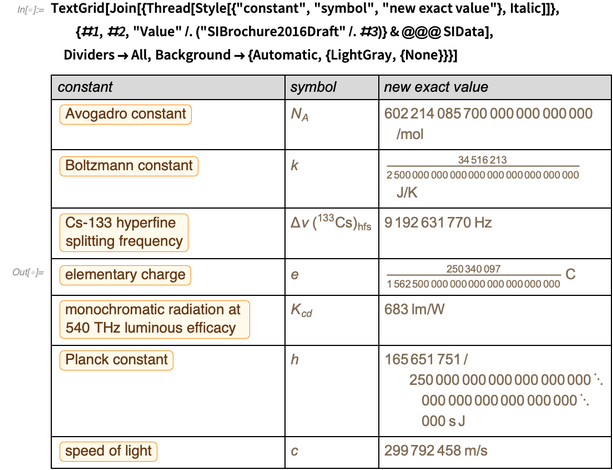
Many physical constants can be related by equations defined by physical theories of various fields of physics. In the future, we want to limit ourselves to the theory of fundamental electromagnetic phenomena, in which the error of the constants will be reduced to the error of the fine structure constant
 and Rydberg constant
and Rydberg constant  . If we included, for example, gravitational phenomena, we would have to use the gravitational constant G, which is measured independently, although it has a very large error (which is why the NSF had the so-called “ Big-G Challenge ”).
. If we included, for example, gravitational phenomena, we would have to use the gravitational constant G, which is measured independently, although it has a very large error (which is why the NSF had the so-called “ Big-G Challenge ”). Next, we confine ourselves to electrical, magnetic, and mass quantities, the errors of which are reduced to units
 and
and  .
.Below we use the new Around function to express values with corresponding errors.
 and
and  .
. 

Currently, according to CODATA 2014, the relative error for
 is about
is about  , and for
, and for  about
about  . As you can see, the error for
. As you can see, the error for  more than for
more than for  .
.

Below is a graph of the log-base-10 relative error
 as functions a and b . It is obvious that for small degrees the relative error of the product weakly depends on the exponents a and b . This graph shows that the dependence of the error
as functions a and b . It is obvious that for small degrees the relative error of the product weakly depends on the exponents a and b . This graph shows that the dependence of the error  dominates relative to a (exponent of the fine structure). This observation is explained by the fact that the error of the Rydberg constant is 50 times less than the error of the fine structure constant.
dominates relative to a (exponent of the fine structure). This observation is explained by the fact that the error of the Rydberg constant is 50 times less than the error of the fine structure constant. 
To calculate the errors of different constants in the new SI, we will use the following steps:
• Extracting equivalent representations for physical constants available from the “ PhysicalConstant ” entity class.
These identical equalities between physical constants are laws of physics and, as such, should be preserved both in the old and in the new SI.
• Perceive formulas as a set of algebraic equalities to which various exclusion methods can be applied to express a constant through a combination of the seven basic constants of the new SI, as well as the fine structure constants
 and Rydberg constants
and Rydberg constants  .
.These are the nine basic constants that we allow to apply in the definitions of each new constant under consideration. (Technically, there are 10 constants in the list, but due to the simple scaling relation between h and ℏ , there are nine “different” constants in this list.)

The entity class of the object “ PhysicalConstant ” contains a lot of information about the relationship between physical constants. For example, here are the equivalent forms of the four constants, which are currently being measured and will soon be identified as having exact values.
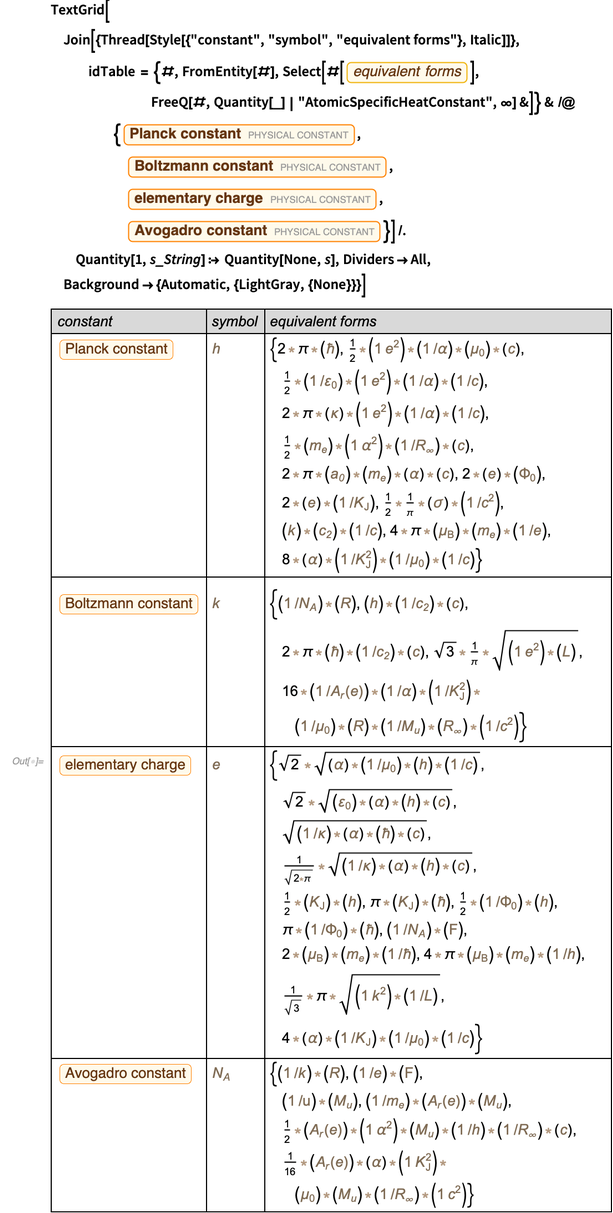
Within the limits of the accuracy of the measured values, all these individual elements work now. Here is a quick numerical check of alternative forms of Planck’s constant. But the specific numerical value, especially the error, depends on the actual form of the representation. Using Around [], we can easily calculate the resulting errors.

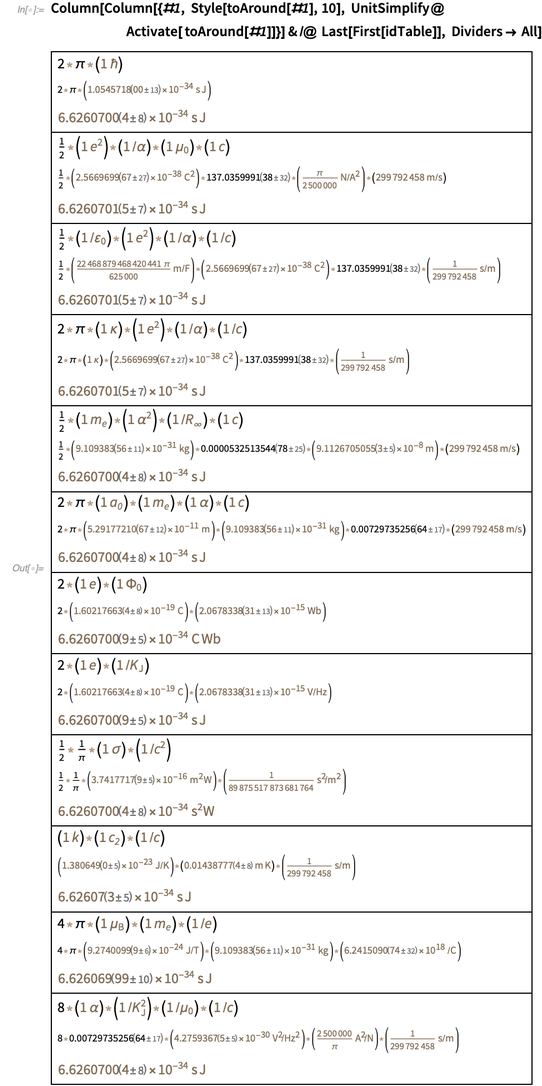
Below is a graphical representation of the resulting errors of various representations. A very large error of tens of representations can be traced to a large error in the second constant radiation.
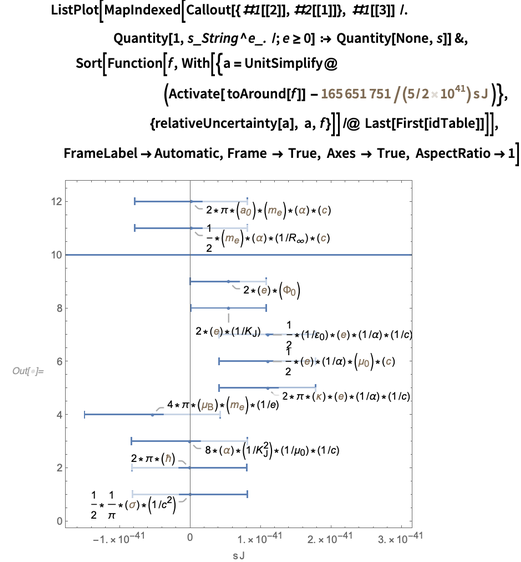
And again, in the framework of the error of constants, this relationship should be maintained after the redefinition. , ? , , , , , .
, , ( , Entity [" PhysicalConstant",. ] Quantity [ 1 ,. ] ). , , , : -, , ; -, ( GroebnerBasis ) , .



. : (1) ; (2) (, ) . LCM ( ) .

, .

. .

toPolynomial , , . ℏ
 , .
, . 
, ( , SI), .

.
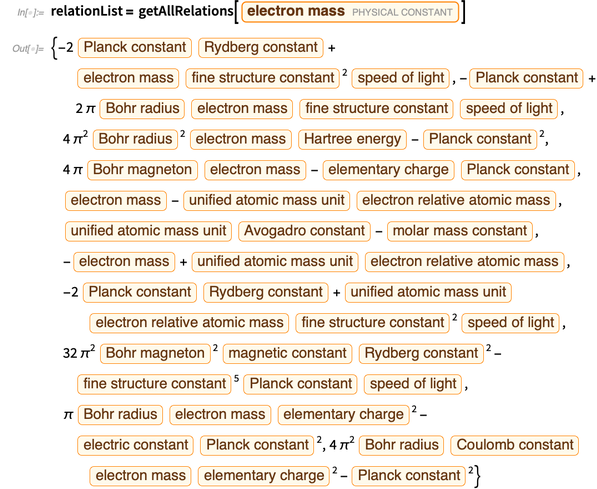
 and
and  . , . , , ( ) . , , ; , .
. , . , , ( ) . , , ; , . 
 and
and  GroebnerBasis . MonomialOrder -> ElventionOrder , « » , ( ) .
GroebnerBasis . MonomialOrder -> ElventionOrder , « » , ( ) . 
, ,
 .
.

 . ,
. ,  , .
, . 

, , , — .
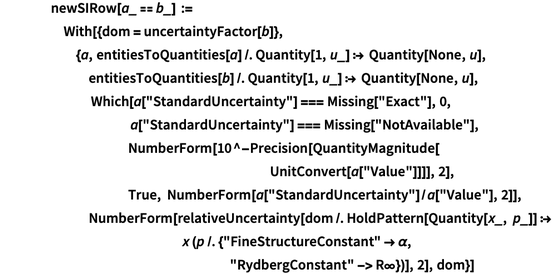
. ; ( , ).
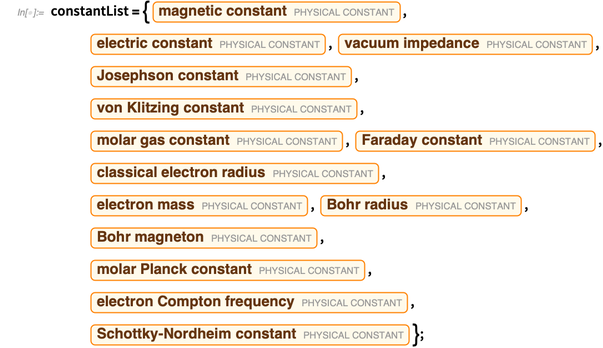
SI.

, , .

 and
and  in such a way that after reduction the result
in such a way that after reduction the result  becomes
becomes .A similar list can be found at the bottom of the Wikipedia page on the redefinition of SI units .
.A similar list can be found at the bottom of the Wikipedia page on the redefinition of SI units .Now we can calmly expect World Metrology Day 2019 for a fundamentally better world, described through fundamental constants.
Download the Wolfram Notebook blog .
Free Wolfram Mathematica free version
Have questions? Contact info-russia@wolfram.com
Source: https://habr.com/ru/post/451162/
All Articles